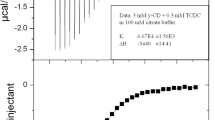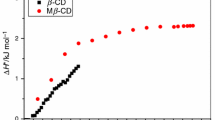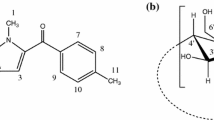Abstract
The binding of diflunisal to hydroxypropyl-β-cyclodextrin (HPβCD), bovine serum albumin (BSA), human serum albumin (HSA), normal human plasma, and mixed solutions of HPβCD/ protein was studied at 25°C, pH 7.4, by potentiometry using an electrode selective to diflunisal. The experimental data for diflunisal/ HPβCD fit well to the 1:1 binding model. The binding of diflunisal with each of the studied proteins was compatible with a model having two independent classes of binding sites. The binding of diflunisal in mixed solutions HPβCD/BSA, HPβCD/HSA, and HPβCD/plasma increased considerably when the HPβCD concentration was increased. The binding behavior of the two biomolecules in the mixed solutions of HPβCD/BSA or HPβCD/ HSA was described with an “additive” model formulated on the basis of the estimates of the binding parameters of diflunisal derived from the separate experiments with each one of the binders tested. The lower than theoretical binding observed in HPβCD/plasma solutions was ascribed to the competitive displacement of diflunisal from the HPβCD cavity by plasma cholesterol.
Similar content being viewed by others
REFERENCES
J. Pitha, J. Milecki, H. Fales, L. Pannell, and K. Uekama. Hydroxypropyl-β-cyclodextrin: Preparation and characterization; Effects on solubility of drugs. Int. J. Pharm. 29:73–82 (1986).
M. E. Brewster, M. S. Hora, J. W. Simpkins, and N. Bodor. Use of 2-hydroxypropyl-β-cyclodextrin as a solubilizing and stabilizing excipient for protein drugs. Pharm. Res. 8:792–796 (1991).
D. Duchene (ed.), New Trends in Cyclodextrins and Derivatives, Editions de Sante, Paris, 1991.
K. S. Estes, M. E. Brewster, A. I. Webb, and N. Bodor. A non-surfactant formulation for alfaloxone based on amorphous cyclodextrin: Activity studies in rats and dogs. Int. J. Pharm. 65:101–107 (1990).
M. E. Brewster, J. W. Simpkins, M. S. Hora, W. C. Stern, and N. Bodor. The potential use of cyclodextrins in parenteral applications. J. Parent. Sci. Technol. 43:231–240 (1991).
H. W. Frijlink, A. C. Eissens, N. R. Hefting, K. Poelstra, C. F. Lerk, and D. K. F. Meijer. The effect of parenterally administered cyclodextrins on the cholesterol levels in the rat. Pharm. Res. 8:9–16 (1991).
T. Irie, K. Fukunaga, and J. Pitha. Hydroxypropyl-cyclodextrins in parenteral use. I. Lipid dissolution and effects on lipid transfers in vitro. J. Pharm. Sci. 81:521–523 (1992).
T. Irie, K. Fukunaga, M. K. Garwood, T. O. Carpenter, J. Pitha, and J. Pitha. Hydroxypropylcyclodextrins in parenteral use. II. Effects on transport and disposition of lipids in rabbit and humans. J. Pharm. Sci. 81:524–528 (1992).
T. Nagai, O. Shirakura, and N. Nambu. Hypnotic potency, and the plasma and brain concentration of hexobarbital in the presence of cyclodextrins. In 3rd Int. Conf. Pharm. Technol., Paris, 31 May/2 June 1983, Vol. V, pp. 253–262.
O. Shirakura, N. Nambu, and T. Nagai. Effect of β-cyclodextrin on disposition of hexobarbital and phenobarbital in mice. J. Incl. Phenom. 2:613–621 (1984).
H. W. Frijlink, E. J. F. Franssen, A. C. Eissens, R. Oosting, C. F. Lerk, and D. K. F. Meijer. The effects of cyclodextrins on the disposition of intravenously injected drugs in the rat. Pharm. Res. 8:380–384 (1991).
A. Sharma, K. Anderson, and J. W. Baker. Flocculation of serum lipoproteins with cyclodextrins: Application to assay of hyperlipidemic serum. Clin. Chem. 36:529–532 (1990).
M. E. Ressing, W. Jiskoot, H. Talsma, C. W. van Ingen, E. C. Beuvery, and D. J. A. Crommelin. The influence of sucrose, dextran, and hydroxypropyl-β-cyclodextrin as lyoprotectants for a freeze-dried mouse IgG2a monoclonal antibody (MN12). Pharm. Res. 9:266–270 (1992).
R. K. Verbeeck, A. Boel, A. Buntinx, and P. J. de Schepper. Plasma protein binding and interaction studies with diflunisal, a new salicylate analgesic. Biochem. Pharmacol. 29:571–576 (1980).
T. Christopoulos and E. Diamandis. Binding studies using ion-selective electrodes. Examination of the picrate-albumin interaction as a model system. Anal. Chem. 62:360–367 (1990).
G. N. Valsami, P. E. Macheras, and M. A. Koupparis. Binding studies of ions to cyclodextrins using ion-selective electrodes. J. Pharm. Sci. 79:1087–1094 (1990).
G. N. Valsami, P. E. Macheras, and M. A. Koupparis. Binding study of the fluorescence probe 1-anilino-8-naphthalene-sulfonate to human plasma and human and bovine serum albumin using potentiometric titration. Pharm. Res. 8:888–892 (1991).
G. N. Valsami, M. A. Koupparis, and P. E. Macheras. Complexation studies of cyclodextrins with tricyclic antidepressants using ion-selective electrodes. Pharm. Res. 9:94–100 (1992).
E. E. Sideris, G. N. Valsami, M. A. Koupparis, and P. E. Macheras. Determination of association constants in cyclodextrin/drug complexation using the Scatchard plot: Application to β-cyclodextrin-anilinonaphthalenesulfonates. Pharm. Res. 9:1568–1574 (1992).
A. Craggs, G. J. Moody, and J. D. Thomas. PVC matrix membrane ion-selective electrodes. J. Chem. Educ. 51:541–544 (1974).
G. Scatchard. The attractions of proteins for small molecules and ions. Ann. N.Y. Acad. Sci. 51:660–672 (1949).
W. Loscher. A comparative study of the protein binding of anticonvulsant drugs in serum of dog and man. J. Pharmacol. Exp. Ther. 208:429–435 (1979).
M. Otto, P. May, K. Murray, and J. D. R. Thomas. Calibration of ionized calcium and magnesium with ligand mixtures for intracellular ion-selective electrode measurements. Anal. Chem. 57:1511–1517 (1985).
A. Angelakou, G. Valsami, M. Koupparis, and P. Macheras. Use of 1-anilino-8-naphthalene-sulfonate as an ion probe for the potentiometric study of the binding of sulphonamides to bovine serum albumin and plasma. J. Pharm. Pharmacol. 45:434–438 (1993).
Author information
Authors and Affiliations
Rights and permissions
About this article
Cite this article
Sideris, E.E., Koupparis, M.A. & Macheras, P.E. Effect of Cyclodextrins on Protein Binding of Drugs: The Diflunisal/Hydroxypropyl-β-Cyclodextrin Model Case. Pharm Res 11, 90–95 (1994). https://doi.org/10.1023/A:1018901912619
Issue Date:
DOI: https://doi.org/10.1023/A:1018901912619




